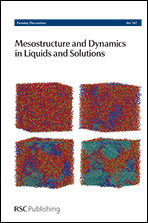Distinguishing aggregation from random mixing in aqueous t-butyl alcohol solutions
Abstract
Raman spectroscopic measurements are combined with various multivariate curve resolution (Raman-MCR) strategies, to characterize the aggregation of t-butyl alcohol (TBA) in aqueous solutions. The resulting TBA solute-correlated (SC) spectra reveal perturbed water OH features arising from the hydration-shell of TBA as well as shifts in the TBA CH vibrational frequency arising from TBA–TBA interactions. Our results indicate that at low concentrations (below ∼0.5 M), there is virtually no TBA aggregation. The first aggregates formed above 0.5 M remain highly hydrated, while those formed above ∼2 M are significantly less hydrated. Comparisons with predictions pertaining to a randomly mixed (non-aggregating) solution indicate that below ∼1 M there are fewer TBA–TBA contacts than would be present in a random mixture, thus implying that the thermodynamic stability of the first hydration-shell of TBA suppresses the formation of direct contact aggregates at low TBA concentrations. Our results further suggest that microheterogeneous domains containing many water-separated TBA–TBA contacts form near a TBA concentration of ∼1 M, while at higher concentrations the TBA-rich domain size distribution may resemble that in a non-aggregating random mixture.
- This article is part of the themed collection: Mesostructure and Dynamics in Liquids and Solutions

 Please wait while we load your content...
Please wait while we load your content...